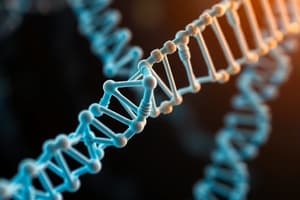Podcast
Questions and Answers
Flashcards
DNA
DNA
Deoxyribonucleic acid; molecule that carries the genetic instructions in living organisms.
RNA
RNA
Ribonucleic acid; molecule involved in protein synthesis and other cellular processes.
RNA function
RNA function
RNA helps build proteins.
DNA vs RNA
DNA vs RNA
Signup and view all the flashcards
mRNA
mRNA
Signup and view all the flashcards
tRNA
tRNA
Signup and view all the flashcards
rRNA
rRNA
Signup and view all the flashcards
DNA replication enzyme
DNA replication enzyme
Signup and view all the flashcards
Transcription product
Transcription product
Signup and view all the flashcards
Hydrogen bonds
Hydrogen bonds
Signup and view all the flashcards
Substitution mutation
Substitution mutation
Signup and view all the flashcards
ATP
ATP
Signup and view all the flashcards
Monosaccharides
Monosaccharides
Signup and view all the flashcards
Glucose
Glucose
Signup and view all the flashcards
Glycosidic bond
Glycosidic bond
Signup and view all the flashcards
Sucrose
Sucrose
Signup and view all the flashcards
Glycogen
Glycogen
Signup and view all the flashcards
Cellulose
Cellulose
Signup and view all the flashcards
Amylase
Amylase
Signup and view all the flashcards
Protein turnover
Protein turnover
Signup and view all the flashcards
Transamination
Transamination
Signup and view all the flashcards
Electron transport chain
Electron transport chain
Signup and view all the flashcards
Study Notes
DNA and RNA
- DNA stands for Deoxyribonucleic Acid
- RNA stands for Ribonucleic Acid
- The primary function of RNA is to help build proteins
- A difference between DNA and RNA is that RNA contains uracil, while DNA contains thymine
Functions of RNA
- mRNA, tRNA, and rRNA are all involved in protein synthesis
DNA Structure
- Hydrogen bonds hold the two strands of DNA together in its double-helix structure
Replication
- Helicase unwinds DNA during replication
Transcription
- mRNA is synthesized from a DNA template during transcription
Mutations
- Substitution mutations occur when one base is replaced by another
- It's a type of point mutation in DNA sequence
Energy Currency
- ATP is the energy currency of the cell
Carbohydrates
- Monosaccharides are the simplest form of carbohydrates
- Glucose is known as blood sugar
- Glycosidic bonds link monosaccharides to form disaccharides
- Sucrose is composed of glucose and fructose
Protein Metabolism
- Protein synthesis, digestion, and turnover are all types of protein metabolism
- Amino acids are involved in forming enzymes and hormones
Enzymes
- Amylase is responsible for breaking down starch into maltose
- Helicase is responsible for unwinding DNA during replication
- DNA polymerase is an enzyme involved in DNA replication
- Ligase is an enzyme involved in joining DNA fragments
- Primase is an enzyme involved in DNA replication
Cellular Respiration
- The electron transport chain generates the most ATP per glucose molecule during cellular respiration
- The mitochondria are the site for Beta-oxidation of fatty acids
Oxidative Deamination
- Ammonia is produced during oxidative deamination of glutamate
Fatty Acid Oxidation
- Acetyl-CoA is a final product in one round of β-oxidation of fatty acids
- Carnitine is needed for transporting fatty acids into the mitochondria for β-oxidation
- The electron transport chain produces the most ATP during cellular respiration
Studying That Suits You
Use AI to generate personalized quizzes and flashcards to suit your learning preferences.




